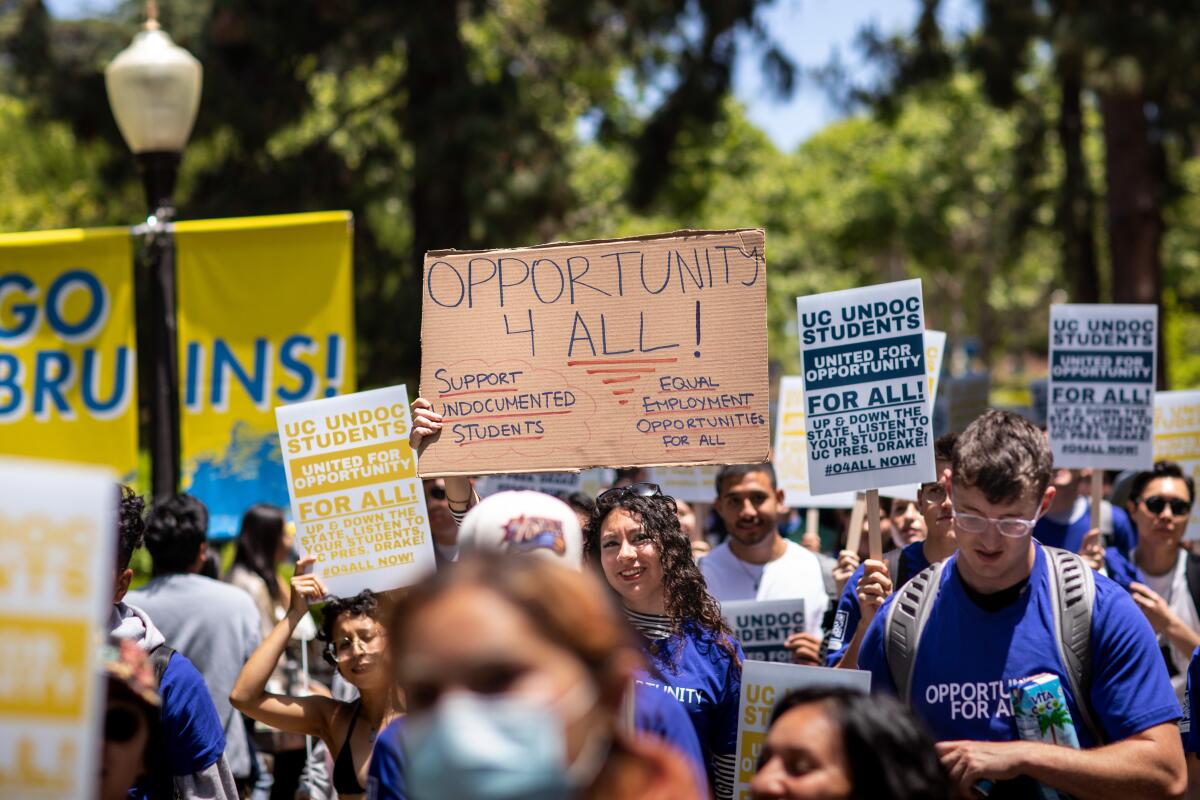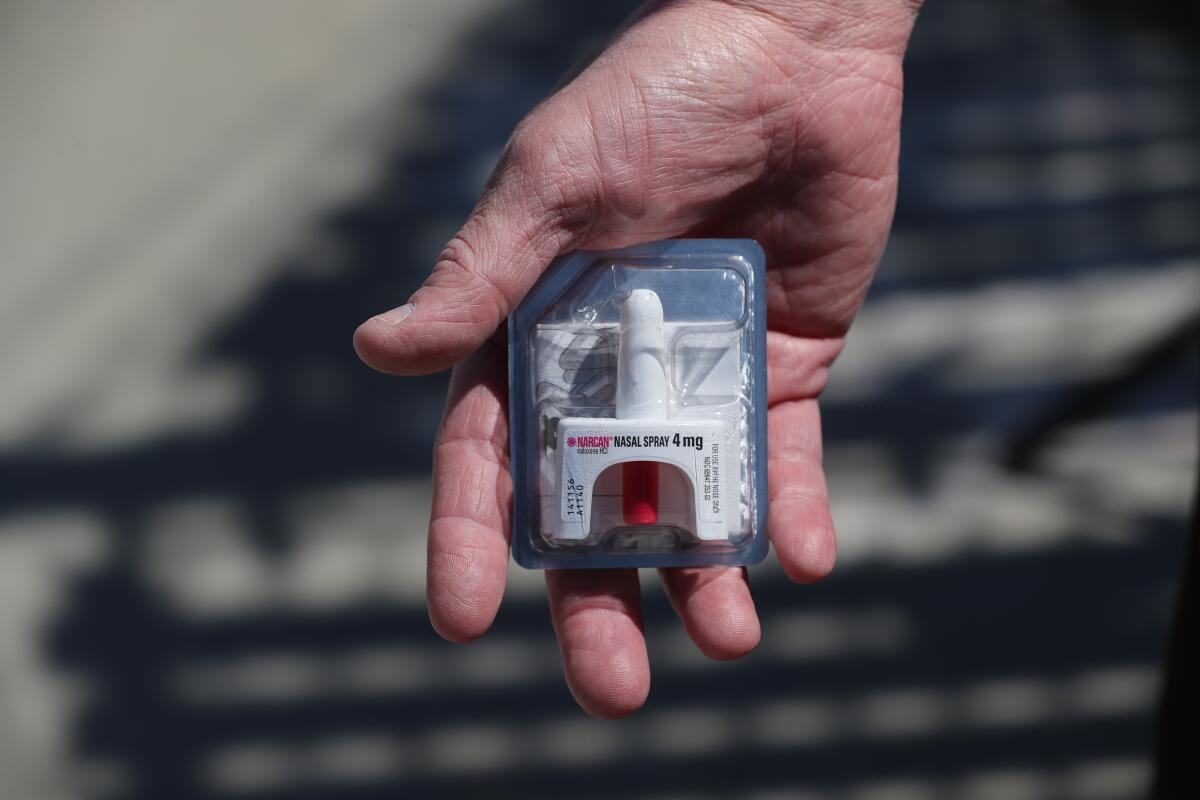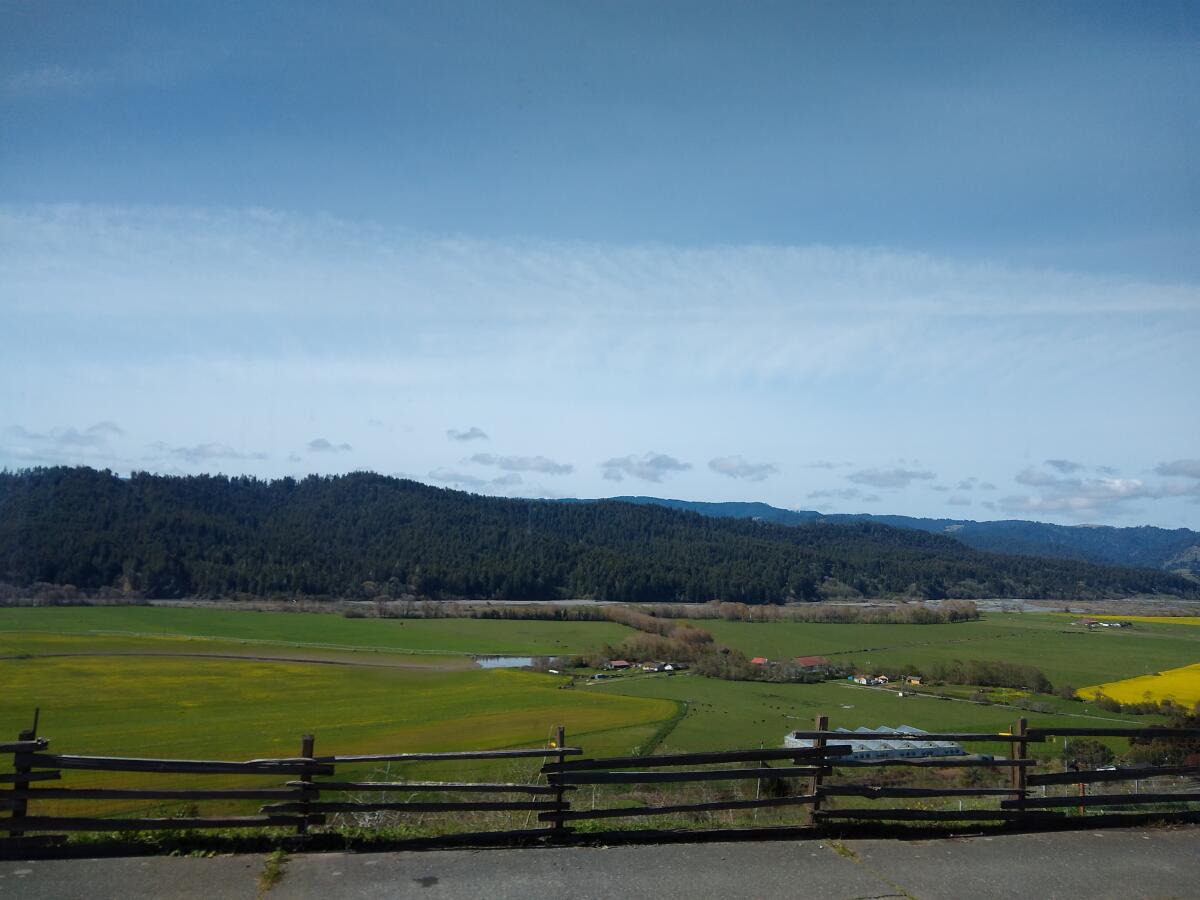Opportunities and consequences loom as UC explores hiring students without legal status

- Share via
Good morning, and welcome to the Essential California newsletter. It’s Monday, May 22.
Roughly 44,000 immigrants without legal status attend college in California. But unlike some of their peers who have been granted protections under the Deferred Action for Childhood Arrival, those students are prohibited from working campus jobs.
University of California leaders want to change that, announcing they’ll start exploring pathways to hire students who aren’t covered by DACA.
The university’s regents voted last week to form a working group that will examine the legal issues involved in making jobs available to the estimated 4,000 such students across the UC system.
“The groundbreaking move would reshape the lives of thousands of young people who were brought to the country without papers as children and have lived precariously without legal access to jobs, research positions and career opportunities,” Times education reporter Teresa Watanabe wrote.
The decision follows a theory put forth by immigration and constitutional law scholars from UCLA challenging the 1986 Immigration Reform and Control Act. They argue that because the states aren’t specifically mentioned in that federal law, it “does not bind state government entities.”
Immigrant students and advocates have also been putting pressure on UC leaders, some of whom expressed concerns about the impact on students, as Teresa explained:
“Some questioned whether hiring students without work authorization would imperil their safety and any future ability to legalize their status. Students, however, say it should be their decision to weigh those risks.”
“It’s these tough decisions where one has to stand up and do the right thing,” Regent Jose Hernandez told The Times. “We need to give every student the same educational opportunity. And right now we have a two-class system where our undocumented students aren’t allowed to partake in gaining that experience that’s going to be useful for their careers.”
Some conservative scholars and lawmakers are warning of consequences should UC leaders act on eventual policy changes.
Rep. Darrell Issa (R-Bonsall) sent a letter to Gov. Gavin Newsom to voice his opposition to the plan. Issa wrote that, should UC leaders follow through with it, he’d like Newsom to “inform Congress how the system intends to refund its current federal funding” and provide estimates of the impacts to students “forgoing future financial assistance.”
UC leaders expect to develop their proposals over the next six months and unveil their plan in November. While there’s a lot of uncertainty between now and then, some of the UC’s immigrant students are marking the moment.
“This is a historic win for the immigrant rights movement that UC has agreed that undocumented students should have equal access, that we should have a seat at the table,” said Karely Amaya, a UCLA graduate student who was brought to the U.S. without papers from Mexico as a toddler.
And now, here’s what’s happening across California:
Note: Some of the sites we link to may limit the number of stories you can access without subscribing.
L.A. STORIES
A South L.A. native is at the helm of a reimagining the Los Angeles film “White Men Can’t Jump.” Grammy-winning director Charles “Calmatic” Kidd II calls the new film a “love letter” to the city. Los Angeles Times
Everybody dies, but here’s a question most of us probably don’t think to ask until we’re in possession of a loved one’s remains: where am I legally allowed to scatter someone’s ashes? My colleague Jessica Roy has a helpful guide for doing so in L.A. County. Los Angeles Times
POLITICS AND GOVERNMENT
Gov. Newsom unveiled a plan to make it easier to build transportation, clean energy and water infrastructure across the state. His aim is to tackle the climate crisis without “being consumed by paralysis and process,” though his plan is facing criticism from both the too-far and not-far-enough camps. Los Angeles Times
Among the hundreds of bills killed by California lawmakers this legislative session was one that would have held oil companies liable for health problems of people who live close to oil wells. Under the bill, authored by Sen. Lena Gonzalez, oil companies would be required to pay up to $1 million to people who have cancer or other health problems associated with a local well. Associated Press
California Middle Class Tax Refunds earmarked for 23 million residents are being held back to help the state with its budget deficit. That roughly $200 million stems from an estimate of qualifying Californians that didn’t account for those who’d died or moved out of state. The Mercury News
CRIME, COURTS AND POLICING
California State University did not investigate claims that the president of their Fullerton campus inappropriately touched students. Internal records and statements show three separate reports against President Framroze Virjee, who told The Times he did nothing wrong. Los Angeles Times
The California Highway Patrol has been stopping fewer people since the onset of the pandemic, but its troopers have been using force more often — most notably in drawing and pointing their guns at people. Data analyzed by the San Francisco Chronicle show that Black people were about twice as likely as white people to experience a use-of-force incident after getting stopped. San Francisco Chronicle
The state’s first CARE Courts are slated to open Oct. 1 in seven counties, allowing judges to order voluntary treatment plans for people with untreated schizophrenia and related disorders. Those counties, which include San Diego, Orange, Riverside, San Francisco, and Stanislaus, are scrambling to prepare for what’s expected to be a heavy volume of cases. Los Angeles Times
Support our journalism
HEALTH AND THE ENVIRONMENT

California is planning to boost spending on Narcan, the nasal spray that counteracts opioid overdoses. But the community groups that hand out the lifesaving drug are in jeopardy of losing workers after a key state grant disappeared. Los Angeles Times
Climate change could wash away up to two-thirds of California’s beaches by the end of the century. That’s according to a not-yet-released study modeling historic rates of coastal erosion and projections for sea level rise, which depend on our ability to reduce greenhouse gas emissions in the coming decades. San Francisco Chronicle
Free online games
Get our free daily crossword puzzle, sudoku, word search and arcade games in our new game center at latimes.com/games.
AND FINALLY
Today’s California landmark comes from Skylar Blue of Hydesville: the breathtaking views of the Eel River Valley.

Skylar writes:
This is the view out my front window. It still takes my breath away after all these years. The Van Dusen River flows in the background. The still working farm [in-view] is decades old and a reminder of the lush and continuing activities of our Mediterranean climate.
What are California’s essential landmarks? Fill out this form to send us your photos of a special spot — natural or human-made. Tell us why it’s interesting and what makes it a symbol of life in the state. Please be sure to include only photos taken directly by you. Your submission could be featured in a newsletter.
Please let us know what we can do to make this newsletter more useful to you. Send comments to essentialcalifornia@latimes.com.
Sign up for Essential California
The most important California stories and recommendations in your inbox every morning.
You may occasionally receive promotional content from the Los Angeles Times.







